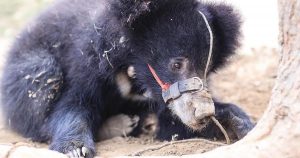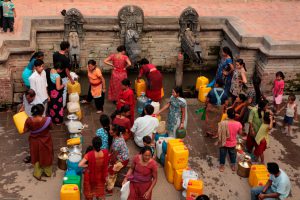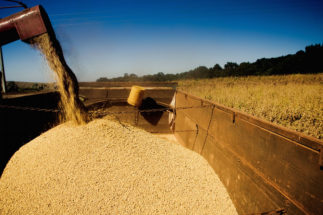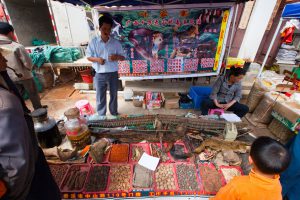“For cotton producers in Pakistan, the last year was the worst in a decade,” said Kazi Abdul Sattar, a 54-year-old farmer from Ghotki in the southern Sindh province.
Sattar was referring to the 60% lower cotton yield on his farm. Even the little that was harvested was of poor quality, he said, as the crop was attacked by the white fly. This year, he has prepared his 70 acres to grow a ‘more profitable’ crop, sugarcane.
There are several factors which have contributed to the low yield. Sattar blames the fluctuating temperature and inconsistent rainfall, which have spelt disaster for the cotton crop. From boll formation to flowering, the crop has sensitive stages of development which are affected by moisture.
Either the sale price must go up or the cost of inputs like fertiliser, diesel, and chemicals must come down drastically before growing cotton is viable.Hasan Abdullah
He is not alone in his predicament. In the city of Muzaffargarh in the Punjab province, farm owner Rabia Sultan has joined the expanding group of farmers in the cotton belt who, in the last decade, have turned to growing sugarcane.
“The heat was abnormal,” said Sultan, a rare female cotton producer in a 1.5 million-strong growers’ community dominated by men. She described how the sudden rise in temperature of 10 degrees Celsius caused the cotton flowers to shed before they matured. “I’ve never seen such intense heat in the month of September.”
A recipient of the first prize for the highest cotton yield in Punjab in 2017, Sultan said it saddens her to see cotton fields shrinking. “Cotton is one crop that is only picked by women, so [a reduction] will bring down the prospect of work for women. It’s an opportunity that has been taken away from them.”
![Two women holding cotton collected from the crop field. “Cotton is one crop that is only picked by women, so [a reduction] will bring down the prospect of work for women. It’s an opportunity that has been taken away from them," said Rabia Sultan [image courtesy: CABI]](https://dialogue.earth/content/uploads/2020/04/Cotton-Pic-3.jpg)
Sultan had already decreased her 100 acres of cotton farmland by half last year, and said she will reduce more to replace it with sugarcane and rice for better profits.
It is no wonder then, that sugarcane is seen as a ‘better’ alternative. Not only is it sturdier in the face of fluctuating weather, it requires less manpower in the fields. Revealingly, the sugar industry also enjoys the patronage of political elite and influential landowning families, and is therefore able to secure favourable policies.
It is this saga of powerful sugar-mill owners, ensuing advantageous policies for cane and the impact of climate change that have together culminated in a decline in Pakistan’s cotton production. The issue has been compounded by a lack of investment in research and development for cotton, resulting in poor quality of crops, lower market prices and a stunting of industry growth.
If this continues, Pakistan stands to lose the enviable position of being the fifth-largest cotton producer in the world. Not only do cotton and its products contribute about 10% to the country’s gross domestic product, they account for 55% of the foreign exchange earnings of the country. Of Pakistan’s total exports of USD 23.7 billion in 2018, the textile industry accounted for more than 50% at USD 13.53 billion.
The switch from cotton to sugarcane is evidenced by the change in farmed land for the two crops. While cotton producing farmland has fallen by 12% in the last five years, sugarcane has witnessed a near 40% increase in the last eight. Farmers were barely able to muster 9.86 million bales of cotton last year against the target of 14.4 million bales.
This year, the Pakistan Cotton Ginners Association (PCGA) recorded a 20% drop in cotton crop arriving at ginning factories by January 15. As a result, the textile industry was compelled to import raw cotton to ensure its contribution in Pakistan’s exports.
“Pakistan’s domestic demand exceeds supply, forcing us to spend around up to USD 2 billion on the import of raw cotton,” said Hammad Naqi Khan, head of WWF-Pakistan. As a cash crop, it should play an important role in the country’s economic and social development, he said, adding that it should be included in the Prime Minister’s Agriculture Emergency Programme as a priority.
The reality, however, is starkly different. While PKR 19.3 billion (USD 115 million), PKR 11.4 billion (USD 68 million) and PKR 4 billion (USD 24 million) respectively have been set aside for enhancing the production of wheat, rice and sugarcane, cotton does not feature on the government’s priority list.
From Sindh to Punjab, the farmers’ woes are the same. “I will be growing less cotton and more sugarcane this season,” said Hasan Abdullah, a farmer from Sadiqabad in the cotton belt of Punjab. “Either the sale price must go up or the cost of inputs like fertiliser, diesel, and chemicals must come down drastically before growing cotton is viable,” he told thethirdpole.net.
Benefits of sugarcane crop
With climate change “out of one’s control”, many farmers have gradually shifted to the ‘safer’ option of sugarcane.
![workers loading a truck with sugarcane. Sugarcane keeps widening its ambit, even in water-scarce regions like Sindh's Thar areas [image by: Tahir Saleem]](https://dialogue.earth/content/uploads/2020/04/20121230_Thar_Sindh-366-1.jpg)
“Cotton is a very sensitive crop and susceptible to pests. Given the inclement weather, it makes more sense to turn to hardier crops,” said Mahmood Nawaz Shah, the vice-president of a local farmers’ organisation in Sindh, who has made the switch.
Shahid Afghan, the CEO of Faisalabad-based Sugarcane Research and Development Board, agreed. He described cane as “stress tolerant grass”.
“Despite the water stress, sugarcane is preferred due to its resilience to climate change impacts,” said Afghan. “If there are floods, crops such as cotton or rice may be completely destroyed, but cane will survive and stand tall in the water for up to two months. The yield may suffer, but the grower is not left with a total loss, which is the opposite of what happens with cotton,” he said.
This is one reason why Pakistan is the fifth largest producer of refined sugar after Brazil, India, Thailand and China.
Sugarcane industry in Pakistan
The shift in crop farming has not occurred overnight. As Sultan puts it, “It is the result of the last several decades of state policies which, by default or design, have favoured sugar mill owners. Many of them sit in the parliament or have political backing.”
Influential sugar mill owners dominate have the political clout to influence policy. When it comes to political links, undoubtedly textile mill owners, too, have clout. But their influence does not match that of the sugar barons — a reality bolstered by the fact that the last three ruling parties in Pakistan have strong connections to the sugar industry. In fact, as recently as this week, a close ally of Prime Minister Imran Khan was named in a federal probe on the recent sugar crisis.
On paper, a lot of farmers have talked about crop zoning. Even farmers growing sugarcane want to diversify the crops they grow, as they are wary of climate change impacts on yield. Yet, though ecological crop zones exist, administration is poor; sugarcane continues to thrive in canal-fed South Punjab which is hardly ideal for it given how much water it requires.
Sugarcane needs to be watered up to 16 times, compared to cotton which needs water on six to eight occasions in one season. According to Afghan, cane consumes as much water each year as that stored in the Mangla dam, the country’s second biggest reservoir. LEAD, a Pakistani thinktank working on issues of sustainable development, cites the water usage difference as almost double for sugarcane compared to water, with crop water requirement ranging from 1,000 mm in the northern temperate zones, to 1,900 in the southern, arid areas. In comparison cotton consumes 587 mm and 1,000 mm in the respective regions.
Zahid Mahmood, the director of the Multan-based national Central Cotton Research Institute (CCRI) said cotton requires much more attention and hard work than sugarcane and is a much more difficult plant to grow. The farmer has to be in the field, under the scorching sun, for months. In contrast, for cane, the harvesting part is the only time the crop needs attention and manpower,” said Mahmood.
Today, there are 38 sugar mills in Sindh and 50 in the Punjab — of which some 40 are owned by politicians. These can comfortably meet the domestic demand of 5.6 million tons. In total, Pakistan has 95 mills.
“We produce more than enough to meet our needs,” said Afghan, adding that “there is no need to add more mills.”
Genetically modified seed
Climatic influences are not the only phenomenon contributing to the shift to sugarcane. “The changing climate may have accentuated the challenges of growing cotton, but it cannot be held solely responsible for the switch to cane,” said Afghan, who has over 30 years of experience in the research, development and innovation of sugarcane crop production.
Poor research on agronomic techniques and a failure to improve seed quality are major contributing factors.
The woes of the cotton crop, he said, started with the introduction of genetically modified Bt cotton which was suffering from a pest problem. “It’s funny that while we cannot grow genetically modified (GM) cane, corn and rice, a non-food crop like GM cotton is allowed.”
He said this has contaminated the food chain, as Bt cotton is the source seed for livestock, oil and fibre. “For this reason, now we cannot control the pest problem,” he pointed out.
“Bt has lost its Bt-ness and doesn’t provide any advantages anymore,” said Abdullah, the farmer from Sadiqbad. “Insects have developed resistance to it.” The utter lack of research in the field has only compounded the problem. “Bt genes must be improved constantly [if we want] to stay ahead of insects. The rest of the world did it and is now at fourth generation Bt; and we haven’t been able to manage the first generation,” he lamented.
The flooding of the market with pesticides and their ‘blind’ application on Bt cotton led to some pests becoming resistant to diseases. Conversely, eco-friendly insects needed to keep crops and the environment healthy were killed.
“Our farmers who are trapped with loans to buy inputs were lured and coerced into buying these pesticides without much knowhow. The uneducated and uninformed farmer sprayed excessively, often at the wrong time, leading to killing even those insects that eliminated those that harmed the cotton crop. The latter developed an immunity to pesticides,” said Afghan.
Abdullah said farmers like him spray eight to 15 rounds of chemicals on their cotton crop, as they are not pest resistant varieties, over a five-six month period. In sharp contrast, Australia sprays a maximum of two rounds managing it biologically.
“[The solution lies in] genetics and management and we lose on both fronts,” said Abdullah.
While there may be many reasons for the abuse of pesticides, Shah of Abadgar blamed the “absence of extension services to guide farmers” to be a major one. This is seconded by Abdullah.
Following the profit
Another challenge making cotton farming ‘impossible’ is the high price of production.
![Farmers will plant what sells well; Dadu Singh with his sugarcane crop [image by: Tahir Saleem]](https://dialogue.earth/content/uploads/2020/04/20161231_Dadu_Sindh-432.jpg)
“Farmers will turn to what sells well,” said Sultan. “When they found takers of their harvest at their doorstep, they started growing cane.” She added that the government does not help by promoting one crop over the other and that if the cost of production and pesticide continues to increase, cotton will be elbowed out.
“Pesticides are our biggest expense, followed by fertiliser and diesel,” said Abdullah, comparing it to sugarcane where cost of production per acre is a maximum of USD 300-360 per acre to cotton which could be USD 360-470 per acre.
“There is always the niggling fear at the back of a farmer’s mind about whether the crop will come to fruition or get destroyed by the disease,” he said.
The farmer’s decision to grow a crop is not based on national interests, or the cotton requirement for the textile industry but on the economic health of his own farm.Shahid Afghan
Afghan endorsed this view, “The farmer’s decision to grow a crop is not based on national interests, or the cotton requirement for the textile industry but on the economic health of his own farm.” He pointed out that Bangladesh, a leading player in the textile industry, grows very little cotton.
Further, cane offers better returns compared to cotton, which suffers from price fluctuation in the international commodity market, said the SRDB chief. The devaluation of the Pakistani rupee has only added to the woes.
Cost of production for sugarcane is lower compared to cotton also because it does not require seed sowing.
“When the farmer harvests cane, he usually leaves a bit of the shoot and the root intact and a new plant grows from it,” Afghan said, illustrating how this step saves cost. Even in Sindh, where more than 80% of the crop requires seed, the seed comes from the same sugarcane or a newer, better tested variety.
Room for government intervention
Senior economist and a farmer, Pervaiz Amir, said the government should go an extra mile for cotton growers. The recent announcement of reduction in fertiliser prices, he said, remains unimplemented to date. He demanded that it be brought to par with prices in other countries.
CCRI director Mahmood said the cost of fertiliser for an Indian farmer is USD 1.65 for 50 kg but his counterpart in Pakistan pays a whopping USD 12.24 per 50 kg. “It is not just fertiliser, the price of inputs increase exponentially as the season progresses and the government turns a blind eye.”
Sultan pointed out that after the 18th Constitutional Amendment, agriculture became a provincial subject and the once-thriving national cotton research and development (R&D) institute is in the doldrums.
“The textile industry, too, said Sultan, has shown little interest in propping up the flailing cotton crop. There should have been development of newer pest-resistant varieties that gave higher yield and lowered the cost of production,” she said.
Ultimately, the problem is amplified by the perpetual disconnect between research and extension services in Pakistan’s agriculture, said Abdullah. This is why the crop performs poorly, and it is little wonder that Pakistan stands 13th in the world for yield per acre in the cotton crop.
Ray of hope
Even with all its problems, all is not bleak for the cotton crop and grower.
While the area on which cotton was grown has decreased, Mahmood said the yield per acre has increased “ten-fold”. And, he said, his institute, the CCRI, has not been sitting idle since it was restarted in 1970.
“We have successfully developed and even approved 30 high yielding cotton seed varieties to increase per acre crop in the last almost 50 years. “These varieties are resistant to disease and pests and tolerant to drought. At the same time they are high yielding,” he said.
Abdullah said all this development has occurred in the last four years. “Prior to 2016, cotton crop went through a terrible time. We were producing low quality cotton and that too, in insufficient quantity, so a lot of it had to be imported,” he said.
Balochistan goes organic
Another encouraging development has come from Balochistan’s tribal areas, where small farmers had been growing organic cotton on land that was cleaned of chemical fertilisers and pesticides and finally got certification last year. Cotton was successfully grown without the use of chemical fertiliser or pesticide and the seeds were not genetically modified.
The project was started in 2015 by WWF-Pakistan in collaboration with Balochistan’s Directorate of Agriculture Extension and financial support from the C&A Foundation.
“We worked with 6,000 farmers who produced 9,500 bales over 16,000 acres of land. While the farmers saved on the cost of production, the yield was naturally low since the seed was not genetically modified and no fertiliser was used,” said Asad Imran, of WWF who was leading the project.
“But they made up for it by getting a higher price because it was organic,” he added.
![<p>Due to lack of investment, research and helpful policies, cotton is making way for sugarcane in Pakistan [image courtesy: CABI]</p>](https://dialogue.earth/content/uploads/2020/04/Pakistan-cotton-farmer.jpg)








